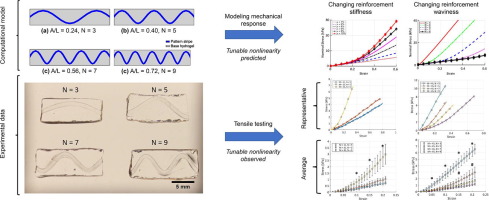Acta Biomaterialia ( IF 9.4 ) Pub Date : 2018-05-24 , DOI: 10.1016/j.actbio.2018.05.036 Shail Maharshi Mehta , Tao Jin , Ilinca Stanciulescu , K. Jane Grande-Allen

|
Biomaterials for tissue engineering that recapitulate the mechanical response and biological function of native tissue are highly sought after to lessen the burden of damaged or diseased tissue. Poly(ethylene glycol) diacrylate (PEGDA) hydrogels are a popular candidate because of their favorable bioactive properties. However, their mechanical behavior is very dissimilar to that of biological tissue, which behaves in a mechanically anisotropic, nonlinear, and viscoelastic fashion. It has been previously shown that PEGDA hydrogels can be patterned in alternating linear strips of different stiffnesses to generate anisotropic behavior, but these constructs still have a linear stress-strain response. In this study, we imparted nonlinear mechanical properties to PEGDA hydrogels by fabricating composite hydrogel constructs consisting of a stiff sinusoidal reinforcement embedded into a softer base matrix. This was achieved by polymerizing low molecular weight (MW) PEGDA hydrogel precursor into a stiff sinusoidal shape and then polymerizing this construct into a high MW precursor. Samples were generated with different relative stiffness between the two components and a range of sinusoid periodicities to assess the tunability of the resulting stress-strain curve. Tensile testing indicates that the sinusoidal patterning gives rise to nonlinear stress-strain behavior. Varying the relative stiffness was shown to tune the slope of the linear region of the stress-strain curve, and varying periodicity was shown to affect the length of the toe region of this curve. We conclude that composite hydrogels with stiff sinusoidally-patterned reinforcements display mechanical properties more similar to those of biological tissue than uniform or linearly-patterned hydrogels.
Statement of Significance
Hydrogel biomaterials are a popular candidate for engineering constructs that can mimic the properties of native tissue for disease modeling and tissue-engineering applications. Studies have shown that poly(ethylene) glycol diacrylate (PEGDA) hydrogels can be fabricated to display many biological aspects of native tissue. However, they are unable to recapitulate fundamental mechanical properties of such tissue, such as anisotropy and nonlinearity. Photolithographic techniques have been employed to generate anisotropic linear PEGDA hydrogels via patterned reinforcement. The present study indicates that such techniques can be modified to generate PEGDA constructs with a sinusoidal reinforcement that display a strongly nonlinear response to tensile loading. This work sets the stage for more intricate patterning for providing increased control over hydrogel mechanical response.
中文翻译:

使用光刻印刷工程化生物可扩展水凝胶
为了减轻受损或患病组织的负担,人们强烈寻求用于组织工程的生物材料,其概括了天然组织的机械响应和生物学功能。聚(乙二醇)二丙烯酸酯(PEGDA)水凝胶由于其良好的生物活性而成为受欢迎的候选物。但是,它们的机械行为与生物组织非常不同,生物组织以机械各向异性,非线性和粘弹性方式表现。先前已经表明,PEGDA水凝胶可以在具有不同刚度的交替线性条中进行图案化以产生各向异性行为,但是这些构造仍然具有线性应力-应变响应。在这项研究中,我们通过制造复合水凝胶结构(包括嵌入软基基质中的刚性正弦形增强物)来赋予PEGDA水凝胶非线性机械性能。这是通过将低分子量(MW)PEGDA水凝胶前体聚合为刚性正弦曲线形状,然后将该结构聚合为高MW前体来实现的。生成的样品在两个组件之间具有不同的相对刚度,并具有一系列正弦曲线周期,以评估所得应力-应变曲线的可调性。拉伸测试表明正弦图形会引起非线性应力应变行为。示出了改变相对刚度来调整应力-应变曲线的线性区域的斜率,并且示出了改变周期性来影响该曲线的趾部区域的长度。
重要声明
水凝胶生物材料是工程构造的流行候选者,其可以模仿天然组织的特性,用于疾病建模和组织工程应用。研究表明,聚乙二醇二丙烯酸酯(PEGDA)水凝胶可以制成天然组织的许多生物学方面的材料。但是,它们无法概括这种组织的基本机械性能,例如各向异性和非线性。光刻技术已被用来通过图案化的增强物来生成各向异性的线性PEGDA水凝胶。本研究表明,可以对此类技术进行修改,以生成具有正弦形增强作用的PEGDA构建体,该结构对拉伸载荷表现出强烈的非线性响应。











































 京公网安备 11010802027423号
京公网安备 11010802027423号